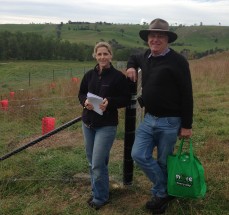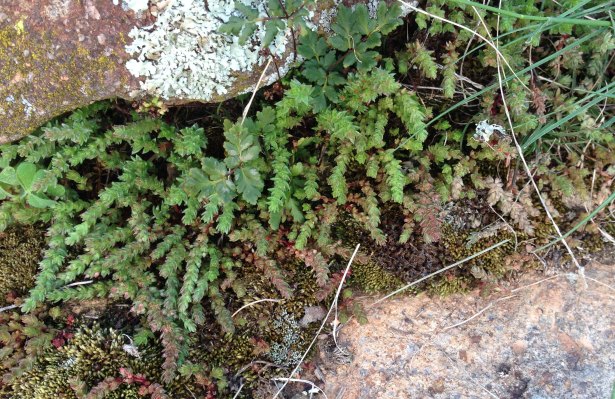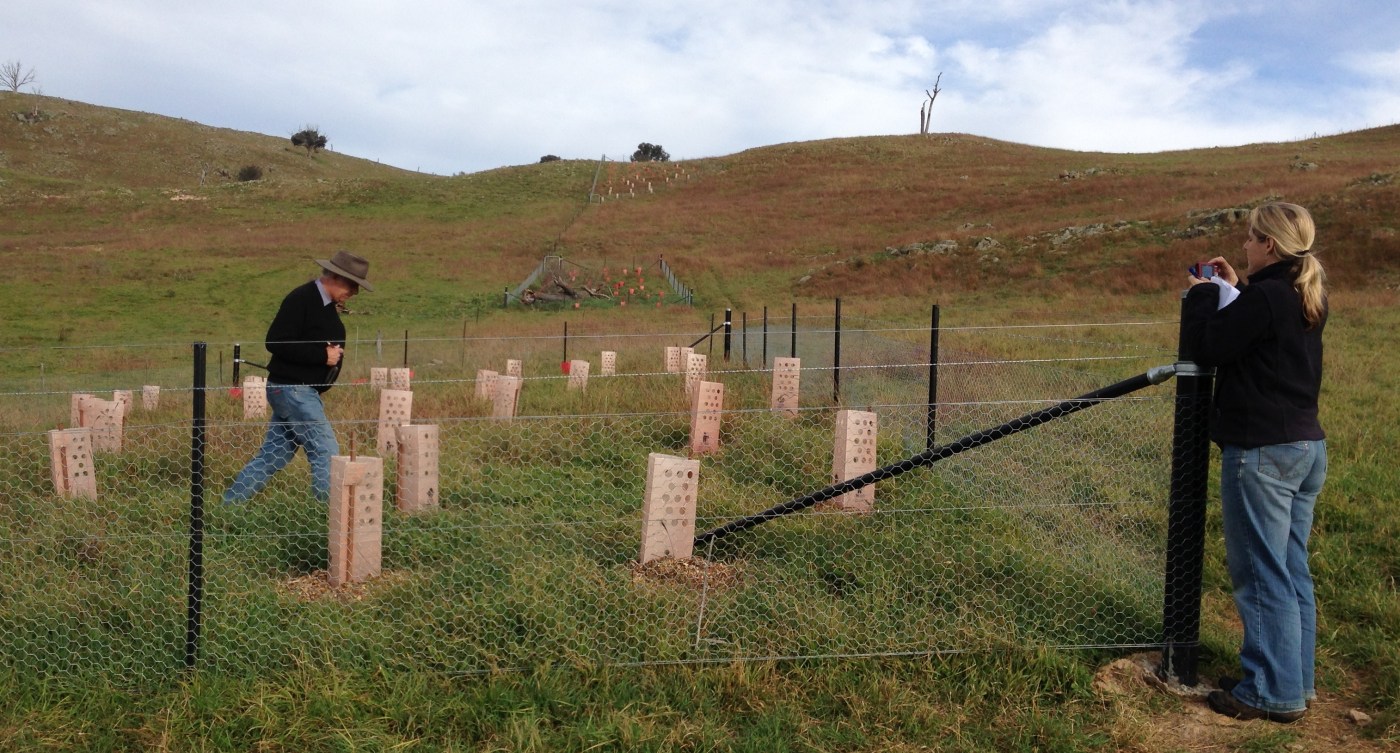
Last autumn we planted up five mini enclosures to provide protection for small native birds and to re-establish a corridor from the Mullion Creek down to the Murrumbidgee River. It turned out to be a great way to get a lot of connection done without a massive amount of time spent planting.
At the time I was glad to see a lot of native speargrasses and scattered clumps of native bluebells (wahlenbergias) among the introduced grasses and weeds.
WHAT WE PLANTED
| Acacia dealbata | Silver Wattle (1) |
| Acacia genistifolia | Early Wattle (3) |
| Acacia implexa | Hickory Wattle (3) |
| Acacia rubida | Red-stemmed Wattle (5) |
| Acacia sp. | a wattle (1) probably Sydney Green |
| Bursaria spinosa | Sweet Bursaria (3) |
| Callistemon sieberi | River Bottlebrush (5) |
| Eucalyptus macrorhyncha | Red Stringybark (1) |
| Eucalyptus melliodora | Yellow Box (4) |
| Eucalyptus polyanthemos | Red Box (3) |
The numbers in brackets show how many of the enclosures include that species.
I’m really happy to have this list as I sometimes lose track of what I planted, and it’s a long hike uphill to check. In the heat of the moment I also sometimes make some odd choices. Putting river bottlebrushes on the top of a ridge, for example.

After we were done planting, Rainer Rehwinkel and Lesley Peden from the Kosciuszko to Coast Foundation came out and paced back and forward in each little area recording all the plants they saw. It was early in the season, so many of them were very tiny.
I looked up and made links on the names for many of the plants that interested me or I didn’t know well. I chose sites that had good information if I could, including the Atlas of Living Australia. There wasn’t one site that covered everything well. Some were fascinating, such as EattheWeeds.com
WHAT RAINER AND LESLEY ALSO FOUND – EXOTIC GRASSES AND FORBS
| Bromus sp.(5) | a brome |
| Holcus lanatus (1) | Yorkshire Fog |
| Hordeum sp. (3) | Barley-grass |
| Lolium sp. | a ryegrass |
| Paspalum dilatatum | Paspalum |
| Phalaris aquatica (2) | Phalaris |
| Trifolium spp. (5) | clover species |
| Vulpia sp. (3) | a rats-tail fescue |
| Amaranthus sp. (2) | an amaranth |
| Arctotheca calendula (2) | Capeweed |
| Capsella bursa-pastoris (2) | Shepherd’s Purse |
| Carthamus sp | a thistle (eg saffron thistle) |
| Cerastium glomeratum | Mouse-eared Chickweed |
| Chondrilla juncea | Skeleton-weed |
| Cirsium vulgare | Spear Thistle |
| Conyza sp. | a fleabane |
| Cucumis myriocarpus | Paddy Melon |
| Echium plantagineum (4) | Paterson’s Curse |
| Erodium cicutarium (5) | Common Stork’s-bill |
| Erodium sp (2) | a stork’s-bill |
| Hirschfeldia incana (3) | Buchan-weed |
| Hypochaeris radicata | Cat’s-ear (flatweed) |
| Malva parviflora (3) | Small-flowered Mallow |
| Marrubium vulgare (2) | Horehound |
| Modiola caroliniana | Creeping Mallow |
| Onopordum acanthium (5) | Scotch Thistle |
| Solanum nigrum (3) | Deadly Nightshade |
| Stellaria media | Chickweed |
| Verbascum thapsus (2) | Great Mullein (Aaron’s Rod) |
| Verbena bonariensisXanthium sp(3) | Purple-top verbenaBathurst Burr |


There were plenty of all of these mainly unwanted things.
The brackets show how many areas had them.
I have detailed information on which area and how common the plants were in the spreadsheet Lesley Peden from K2C gave me.
When I looked up the (unknown to me) Purple-top Verbena online, the results that came back first were how to order it to plant in your garden. Retailers are certainly not helping control the weeds we see around. Mind you, I feel sorry for an industry that has to live with the whims of both fashion and the weather. Grim.
Buchan weed was another I’d never heard of. It turns out to be a brassica, a mustard relative.
I disagree with Rainer about solanum nigrum being “deadly nightshade” as many years ago I took Tim Low’s advice in his book “Bush Tucker” about eating certain weeds. The “blackberry nightshade” (alternate name) berries aren’t bad baked with fetta cheese in a pie. Atropa belladonna (the real deadly nightshade) doesn’t grow in Australia.
The other weed that turned out to be edible was the stork’s bill – apparently pretty good and has a multitude of uses including as a cure for rheumatism. Which I haven’t got, but if I get it it, I only have to hike around the hills collecting the leaves to put in the bath. Sounds like a plan.
Hearteningly, there were also NATIVE GRASSES AND FORBS.
| Cheilanthes sp. | a rock fern |
| Austrostipa bigeniculata | Tall Speargrass |
| Austrostipa scabra (3) | Corkscrew Grass |
| Bothriochloa macra (5) | Red-grass |
| Cynodon dactylon | Couch |
| Elymus scaber | Common Wheat-grass |
| Eragrostis brownii (4) | Brown’s Lovegrass |
| Microlaena stipoides (5) | Weeping Grass |
| Panicum effusum | Hairy Panic |
| Poa sieberiana (2) | Common Snow-grass |
| Rytidosperma sp. (3) | a wallaby-grass |
| Acaena ovina | Sheeps-burr |
| Convolvulus angustissimus | Australian Bindweed |
| Cotula australis | Cotula |
| Crassula sieberiana (2) | Australian Stonecrop |
| Dysphania pumilio (2) | Crumb-weed |
| Geranium sp. | a native geranium |
| Oxalis perennans (3) | Grassland Wood-sorrel |
| Rumex brownii (3) | Swamp Dock |
| Wahlenbergia sp. | a native bluebell |
| Carex sp. (2) | a sedge |
| Juncus sp. | a rush |
| Juncus filicaulis | Pin Rush |

I was surprised initially to see “grass-tree” listed in three of the enclosures. I had no idea they grew around here. I’m more familiar with them from when we lived in Queensland. Xanthorrhoeas do grow around Canberra despite the cold and frosty winters. Some were moved from the enlarged Cotter dam area to the new Arboretum in 2010. They’re very slow growing, so I assumed they must be quite small and not very noticeable. But when I double-checked the name “xanthium” thinking it must be a different group of “xanthorrhoea” I discovered that it was a misprint and I’d had all that excitement for nothing.
“Xanthium”, sadly, is the noxious exotic weed known here as “Bathurst Burr”, in the US as “cockleburr”. A nasty prickly thing that’s been coming up everywhere since the last drought.
More happily, having had the native rock fern pointed out by Rainer, I saw it all over the place. Basically, anything with “rock” in the name is bound to do well here.
The name “Hairy Panic Grass ” is very graphic. It brings to mind a horse getting electrocuted and going berserk. It grows quickly and can be good pasture until it flowers, according to the NSW DPI. I’m hoping our “panicum effusum” is a different species to the “panicum capillare” also known as “witch grass” that poisoned a paddock full of weaners near Horsham in 2010.
Of course, the native plants can’t compete with the weeds for weird common names. The world traveller verbascum thapsus, is also called Aaron’s Rod, Mallion Weed, Great Mullein, Adam’s Flannel, Beggar’s Blanket, Candlewick Plant, Common Mullein, Flannel Mullein, Flannel Plant, Hag’s Taper, Jupiter’s Staff, Molene, Mullein, Velvet Dock, Velvet Plant, and Woolly Mullin.

Or a lifetime! The trouble is the more I know, the harder it is to be a generalist and make sweeping statements. Never mind.
LikeLike
That’s quite a plant list! Great work and hope all goes well with your project?
LikeLike
Thanks. I hope so too. It does get a bit mind-boggling when you start to count all the little grasses and plants, not just the trees.
LikeLike
Yes, One of my projects for this year…..
LikeLike